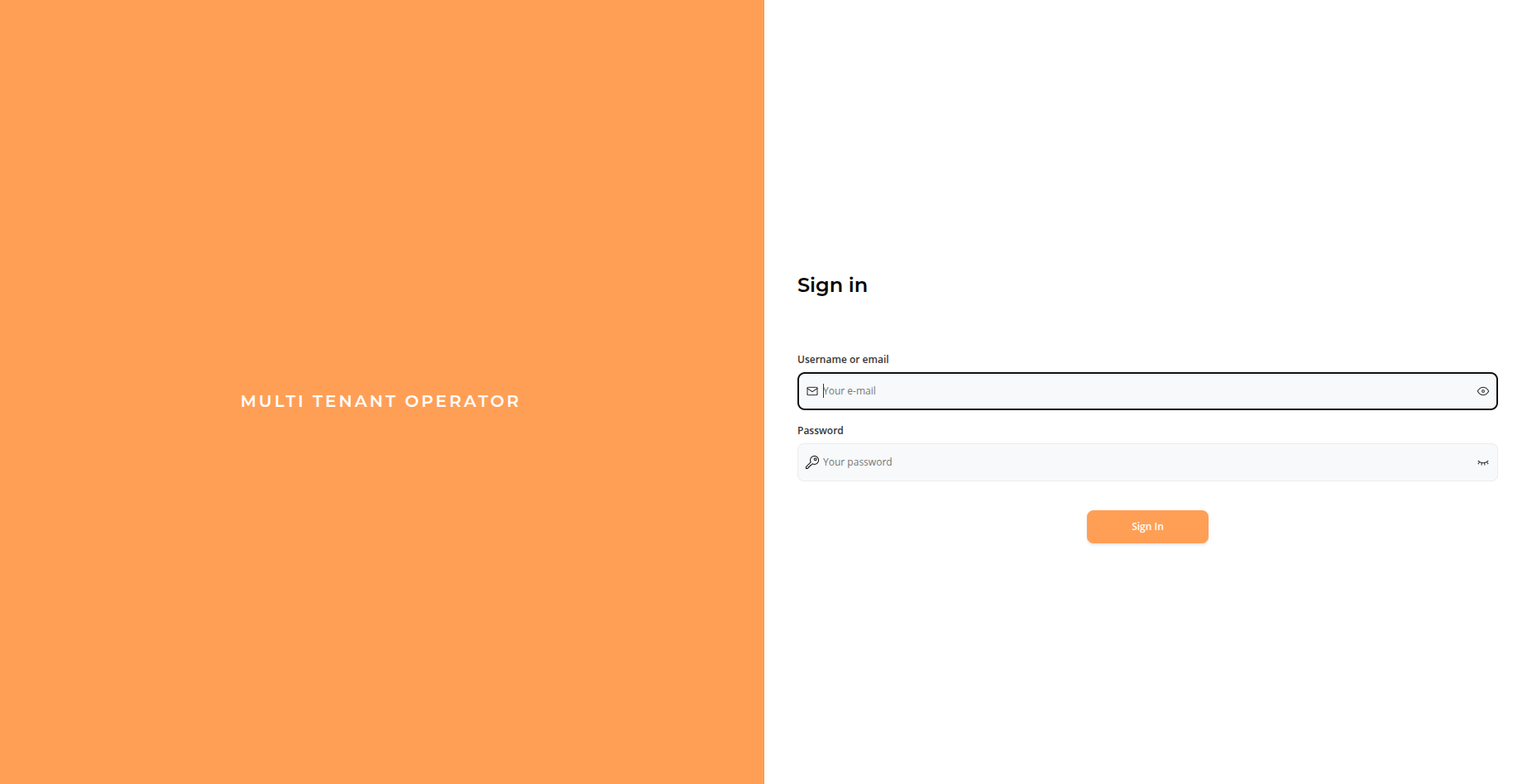Create tenants on EKS Cluster using MTO#
This document provides detailed insights on creating MTO Tenants on EKS cluster. In this tutorial we will assume setup 2 tenants named logistics and retail for an imaginary ecommerce company.
Prerequisites#
MTO must be installed on EKS cluster. MTO EKS installation guide provides a detailed walk-through of MTO installation on EKS.
User Interaction with the Cluster#
We will use two types of users to interact with the cluster, IAM users created via AWS Console and SSO Users.
Creating IAM Users#
We will create a group named logistics-owner and then add a user to that group.
To create a group named logistics-owner use the following command
$ aws iam create-group --group-name logistics-owner
Output:
{
"Group": {
"Path": "/",
"GroupName": "logistics-owner",
"GroupId": "AGPAZFWZTAEJYEKE56O3P",
"Arn": "arn:aws:iam::630742778131:group/logistics-owner",
"CreateDate": "2025-02-03T13:08:56Z"
}
}
Create a user named falcon@nordmart.com
$ aws iam create-user --user-name falcon@nordmart.com
Output:
{
"User": {
"Path": "/",
"UserName": "falcon@nordmart.com",
"UserId": "AIDAZFWZTAEJ7ILHDKLLD",
"Arn": "arn:aws:iam::630742778131:user/falcon@nordmart.com",
"CreateDate": "2025-02-03T13:09:51Z"
}
}
We have created a user named falcon@nordmart.com in AWS Console, with ARN arn:aws:iam::630742778131:user/falcon@nordmart.com.
Create a JSON file to attach the policy. This policy will allow the user to access the cluster.
{
"Statement": [
{
"Action": "eks:DescribeCluster",
"Effect": "Allow",
"Resource": "*"
}
],
"Version": "2012-10-17"
}
Attach a policy to user
aws iam put-user-policy --user-name $name --policy-document file://policy.json --policy-name ClusterAccess
Add user to logistics-owner group
aws iam add-user-to-group --user-name "falcon@nordmart.com" --group-name "logistics-owner"
Generate the access keys that can be used to log in into the cluster. Executing the following command will provide the Access Key Id and Access Secret Key Id that can be used to log in
aws iam create-access-key --user-name "falcon@nordmart.com"
Use the following command to map this user in aws-auth configmap in kube-system namespace.
eksctl create iamidentitymapping --cluster "<CLUSTER_NAME>" \
--region "<AWS_REGION>" \
--arn "<USER_ARN>" \
--username "falcon@nordmart.com" \
--group "logistics-dev" \
--no-duplicate-arns
Since we haven't attached any RBAC with this user at the moment, trying to access anything in the cluster would throw an error
$ kubectl get svc
Error from server (Forbidden): services is forbidden: User "falcon@nordmart.com" cannot list resource "services" in API group "" in the namespace "default"
Repeat the same steps to create a group and a user for retail tenant.
Setting up Tenant for Users#
Now, we will set tenants for the above-mentioned users.
We will start by creating a Quota CR with some resource limits
kubectl apply -f - <<EOF
apiVersion: tenantoperator.stakater.com/v1beta1
kind: Quota
metadata:
name: small
spec:
limitrange:
limits:
- max:
cpu: 800m
min:
cpu: 200m
type: Container
resourcequota:
hard:
configmaps: "10"
memory: "8Gi"
EOF
Now, we will mention this Quota in two Tenant CRs
kubectl apply -f - <<EOF
apiVersion: tenantoperator.stakater.com/v1beta3
kind: Tenant
metadata:
name: logistics
spec:
namespaces:
withTenantPrefix:
- dev
- build
accessControl:
owners:
users:
- falcon@nordmart.com
quota: small
EOF
kubectl apply -f - <<EOF
apiVersion: tenantoperator.stakater.com/v1beta3
kind: Tenant
metadata:
name: retail
spec:
namespaces:
withTenantPrefix:
- dev
- build
accessControl:
owners:
users:
- bear@nordmart.com
quota: small
EOF
Notice that the only difference in both tenant specs are the users.
Accessing Tenant Namespaces#
After the creation of Tenant CRs, now users can access namespaces in their respective tenants and preform create, update, delete functions.
Listing the namespaces by cluster admin will show us the recently created tenant namespaces
$ kubectl get namespaces
NAME STATUS AGE
cert-manager Active 8d
default Active 9d
kube-node-lease Active 9d
kube-public Active 9d
kube-system Active 9d
multi-tenant-operator Active 8d
random Active 8d
logistics-dev Active 5s
logistics-build Active 5s
retail-dev Active 5s
retail-build Active 5s
Logistics Users on Tenant Namespaces#
We will now try to deploy a pod from user falcon@nordmart.com in its tenant namespace tenant-iam-dev
$ kubectl run nginx --image nginx -n logistics-dev
pod/nginx created
And if we try the same operation in the other tenant with the same user, it will fail
$ kubectl run nginx --image nginx -n retail-dev
Error from server (Forbidden): pods is forbidden: User "falcon@nordmart.com" cannot create resource "pods" in API group "" in the namespace "retail-dev"
To be noted, falcon@nordmart.com can not list namespaces
$ kubectl get namespaces
Error from server (Forbidden): namespaces is forbidden: User "falcon@nordmart.com" cannot list resource "namespaces" in API group "" at the cluster scope
Retail Users on Tenant Namespaces#
We will repeat the above operations for our SSO user bear@nordmart.com as well
$ kubectl run nginx --image nginx -n retail-dev
pod/nginx created
Trying to do operations outside the scope of its own tenant will result in errors
$ kubectl run nginx --image nginx -n retail-dev
Error from server (Forbidden): pods is forbidden: User "bear@nordmart.com" cannot create resource "pods" in API group "" in the namespace "tenant-iam-dev"
To be noted, bear@nordmart.com can not list namespaces
$ kubectl get namespaces
Error from server (Forbidden): namespaces is forbidden: User "bear@nordmart.com" cannot list resource "namespaces" in API group "" at the cluster scope
Using MTO Console#
Prerequisites#
- Ensure that MTO Console is enabled by running the following command
$ kubectl get integrationconfig tenant-operator-config -o=jsonpath='{.spec.components}' -n multi-tenant-operator
{"console":true,"showback":true}
If console is set to false then enable the MTO Console before proceeding to next step
- A Keycloak user with same username as AWS IAM user should be created. Follow our Setting Up User Access in Keycloak for MTO Console guide to create a Keycloak user.
MTO Console Log In#
List the ingresses to access the URL of MTO Console
kubectl get ingress -n multi-tenant-operator
NAME CLASS HOSTS ADDRESS PORTS AGE
tenant-operator-console nginx console.iinhdnh6.demo.kubeapp.cloud ae51c179026a94c90952fc50d5d91b52-a4446376b6415dcb.elb.eu-north-1.amazonaws.com 80, 443 23m
tenant-operator-gateway nginx gateway.iinhdnh6.demo.kubeapp.cloud ae51c179026a94c90952fc50d5d91b52-a4446376b6415dcb.elb.eu-north-1.amazonaws.com 80, 443 23m
tenant-operator-keycloak nginx keycloak.iinhdnh6.demo.kubeapp.cloud ae51c179026a94c90952fc50d5d91b52-a4446376b6415dcb.elb.eu-north-1.amazonaws.com 80, 443 24m
Open the URL and Log In with the Keycloak user credentials.
Dashboard will open after the successful login. Now you can navigate different tenants and namespaces using MTO Console

